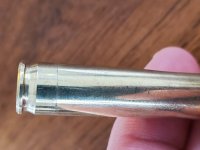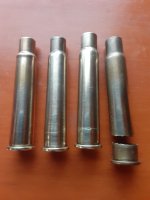slinkylegs
Regular
- Location
- Hudson Bay, SK
I was looking at some of my old 204 brass today, and came across a number of cases like this. They have been fired an unknown amount of times (a half dozen?). I stuck a pick into the case to see if I could feel any thin spots, but there was nothing that stood out to me. Primers weren't that flat (they are Federal, so pretty soft). I don't recall any other signs of pressure. Could it be from the full length due?
Some additional info:
Winchester brass
Tikka T3
Some additional info:
Winchester brass
Tikka T3








































































